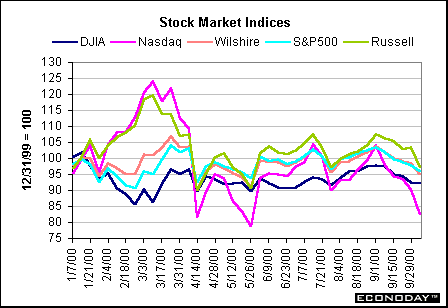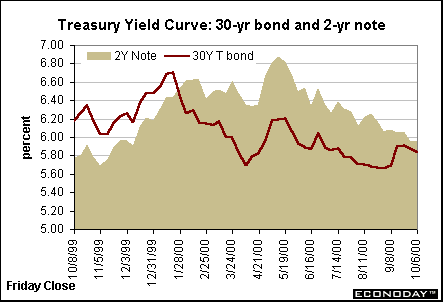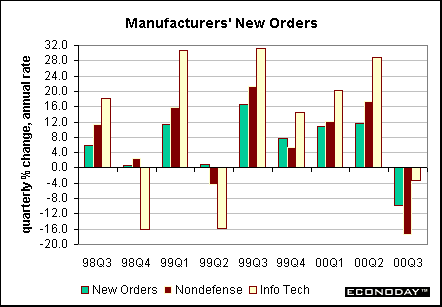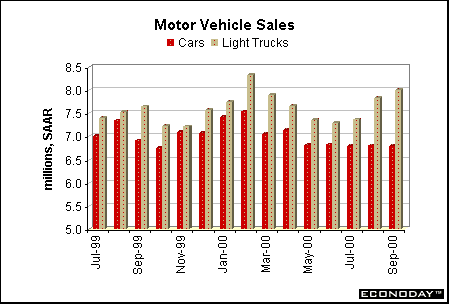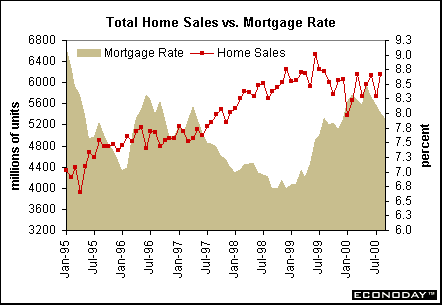| |||||||||||||||||||||||||||||||||||
| Previous Articles |
|
The FOMC met this week and decided to leave the federal funds rate target unchanged at 6.5 percent. The Fed also kept intact the current tightening bias, saying risks are weighted toward inflationary pressures. The minutes of the August meeting revealed that they decided on the inflationary bias to underscore their concerns about long term inflation prospects, although not short term problems. In this week's statement, they also reiterated their worries over the diminishing labor pool. That proved prescient given that September's employment report showed another drop in this series. The jobs report once again put market players on edge, shifting expectations for policy status quo, rather than a removal of the tightening bias and an eventual lowering of rates as well. Worries in the tech sector spread to other markets
Notice the sharp drop-off in all market indices! All are below yearend levels and the Nasdaq is at its lowest since late May/early June. Equities help dampen bond yields
Jobless rate lowest since January 1970!
Clearly, Fed officials worry that a diminishing labor pool will make it more difficult for employers to find workers without increasing wages. As it turns out, average hourly earnings rose a mere 0.2 percent in September, smaller than the increases of the past four months. But market analysts don't believe the modest rise in light of the Beige Book report from a couple weeks ago which indicated wage pressures in the various Federal Reserve districts. Keep in mind that the employment wage series may have its discrepancies but does measure wage changes over time. On a year-over-year basis, average hourly earnings were 3.6 percent higher in September, compared with a 3.8 percent rise last month. As indicated in the chart, average hourly earnings have stabilized in a tight 3.4 to 3.8 percent range in the past year.
Nonfarm payroll employment increased 252,000 in September after declining in each of the two previous months. Remember that all the Census workers who were added to payrolls earlier in the year had to come off payrolls in the past few months. September figures were further muddied by the fact that 75,000 striking workers returned to their jobs. Excluding Census and strike activity, payrolls rose 204,000 in September, a moderate size gain. The chart above depicts the monthly gain relative to the 3-month moving average of payrolls excluding Census. On the bars for payroll changes, months that are colored green denote the months affected by the Census. Even after taking into account all these special factors, it does appear these employment trends have shifted down a gear from a year ago. The bottom-line on the employment situation? Economists typically favor nonfarm payroll employment over the jobless rate as an indicator of current labor market conditions. However, in this environment where labor market conditions are tight and the labor pool is diminishing, the jobless rate might warrant a bit of extra attention - at least that's what Federal Reserve officials will think. The key is strong employment demand not satisfied by supply -- leading to accelerated wage gains. In turn, this should lead to consumer price inflation. That is the old rule of thumb. The one missing link from this is that healthy productivity growth could quell the inflationary aspect of wage gains. So far, that's what we've seen in the U.S. The Fed's job is to determine whether this supportive factor will continue through this year and into the next. In the meantime, market players will become concerned that the potential for Fed easing (which was never very high in the near term anyway) has diminished considerably. Manufacturing activity in the dumps
Other manufacturing indicators also pointed toward weakness. The NAPM survey for September did edge up to 49.9 from 49.5, but any level below 50 percent signals a contraction in manufacturing activity. The production series within this survey surpassed the 50 percent mark for September, but new orders edged down further to 49.1. Backlogs, supplier deliveries and inventories were all below 50 percent. The bottom-line on manufacturing? Manufacturing activity has moderated in recent months, and this will spill over into production in the next few months. This may reassure Fed officials that economic activity is not red-hot. But given the volatile nature of new orders, the picture could easily turn around in the fourth quarter. After all, the sluggish third quarter figures follow some heavy-duty gains over the past four quarters and a pause sometimes refreshes. Consumer spending behavior unchanged
Sales of new single-family homes fell 3 percent in August after surging 11.8 percent in July. Sales are now 2.3 percent below year ago levels. This is in contrast to existing home sales reported last week that showed a 9.3 percent gain for the same month. In the past, these two housing series have moved in tandem, but in the past several months, the two have moved inversely to each other. In any case, the chart below reveals that home sales remain down from their peak of a year ago, but are in a tight range over the past several months. Interestingly enough, mortgage rates have come down from their peaks. In September, the 30-year fixed mortgage rate fell below 8 percent for the first time since December 1999.
The bottom-line on the consumer? Consumer spending on goods and services and investment spending on housing has moderated in the third quarter from the heady pace of late last year and early 2000. However, given the good labor market situation, consumer optimism is high and spending is continuing at a good clip. Fed officials will continue to monitor the consumer sector closely, as it is the principal support behind economic growth. THE BOTTOM LINE Fed officials determined that policy would remain unchanged for the near term. The federal funds rate target was left unchanged at 6.5 percent with a tightening bias. This disappointed market players because they had hoped for the bias to be lifted - and returned to neutral. The funny thing was that expectations were met exactly, because no one really expected the inflation bias to be removed at this meeting. After seeing the September employment situation, market players realized that the Fed policy statement was right on target. Inflation really isn't a problem in the near term - average hourly earnings were up less than expected. But the nation's jobless rate fell to a 31 year low and the available labor pool fell yet again. Nonfarm payrolls are growing more moderately, but at this point, the psychological impact of an unemployment rate that begins with a "3" (3.9 percent) is just plain scary to all. As a result, markets took a tumble because participants no longer expect the bias to go into neutral at the November FOMC meeting. Also, those players looking for a reduction in the fed funds rate soon are also disappointed because it looks so much less likely (It hadn't even been a strong possibility before the employment report.) Next week's data will be sparse. Market players will be looking at inflation figures (PPI) and consumer spending (retail sales) on Friday. Looking Ahead: Week of October 8 to October 13 Thursday The consensus calls for a 0.5 percent gain in import prices in September after a 0.2 percent hike in August. This should come from higher oil prices. (Forecast range: 0.3 percent to 0.9 percent) Export prices are expected to remain unchanged for the month. (Forecast range: - 0.1 percent to 0.3 percent) Friday The producer price index should rise 0.6 percent in September, more than reversing last month's 0.2 drop. This comes from higher energy and food prices. (Forecast range: 0.4 to 0.9 percent) The market consensus shows a 0.1 percent gain in the core PPI in September, the same as last month. (Forecast range: 0.0 percent to 0.3 percent) A reduction in tobacco prices should keep down the rise in the nonfood, nonenergy PPI. Looking Ahead to the Week of October 16 The consumer price index will also be hit by higher energy prices in September. The market consensus is looking for a 0.4 percent hike in the total. (Forecast range: 0.3 to 0.6 percent) Excluding food and energy prices, the CPI is expected to rise 0.2 percent, the same as last month. (Forecast range: 0.1 to 1.0 percent) |
||||||||||||||||||||||||||||||||||||||||||||||||||||||||||||||||||||||||||||||||||||||||||||||||||||||||||||||||||||||||||||||||||||||||||||||||||||||||||||||||||||||||||||



